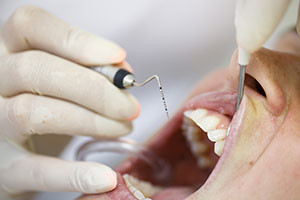 With the several brunches of dentistry, you might be a bit confused as to who does what. There are orthodontists, endodontist, pedodontists and periodontists. And you ask yourself, “What makes them different from my general dentist in Phoenix?” To somehow clear out some of the confusion, let us take a closer look at who a periodontist is, and what exactly does he do.
With the several brunches of dentistry, you might be a bit confused as to who does what. There are orthodontists, endodontist, pedodontists and periodontists. And you ask yourself, “What makes them different from my general dentist in Phoenix?” To somehow clear out some of the confusion, let us take a closer look at who a periodontist is, and what exactly does he do.
Periodontics is a dental specialty that deals with the diagnosis, treatment and prevention of periodontal diseases (conditions that involve the gums and other support structures), and maintenance of a healthy and functional attachment levels or placement of dental implants. They also deal with the treatment of oral inflammations and perform oral plastic surgery.
After receiving a bachelor’s degree in dentistry, one must go for three additional years of formal training in a periodontal residency program accredited by the American Dental Association. After which, a periodontics may earn a national board certification by the American Board of Periodontology. The certification includes passing a comprehensive written and oral exams that focus on all phases of periodontal disease and management. Additionally, one must provide a detailed report on a range of treatments personally done by the periodontist and the reasons behind every procedure done. Such certification is renewed every six years.
Periodontists can work in hospitals, dental schools, own clinic, and state, national and international agencies. They can also opt to focus on research opportunities that study the interrelationships between systemic and periodontal diseases.
A periodontics is capable of performing the following:
Non-surgical periodontal treatments – These include deep cleanings, scaling and root planing where the root surfaces are professionally cleaned to get rid of plaque and tartar This is usually recommended for gum diseases in their early stages.
Surgical Treatment – These procedures include: a) Regeneration or folding back the gum tissue to remove bacteria. To encourage the body’s natural ability to regenerate tissue and bone, membranes, tissue stimulating proteins and bone graft are utilized; b) Pocket reduction which is the folding back of gum tissue for the removal of disease-causing bacteria before being secured into place; and, c) Gingivectomy or the removal of excess tissue under local anesthesia
Plastic Surgery – these surgical procedures include: a) Ridge augmentation, done to correct indentation of gums and jawbone, recapture their natural contour and to make an artificial tooth appear natural in the gum tissue; b) Soft tissue grafting where a gum tissue taken from your palate is used to cover an exposed dental root; and, c) Gingival sculpting or crown lengthening wherein the bone and gum tissues are reshaped to expose more of the natural teeth.
Some periodontal cases may be handled by your general dentist, but more serious needs should be left to the expertise of a periodontist. Phoenix, Arizona houses several of these experts but it is important that you choose one with the credentials and experience. You can also ask your dentist for a referral.